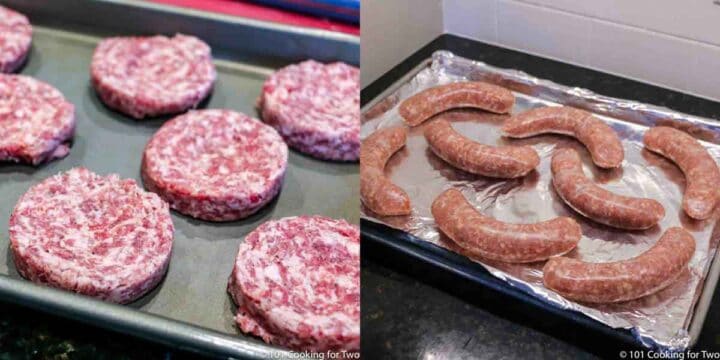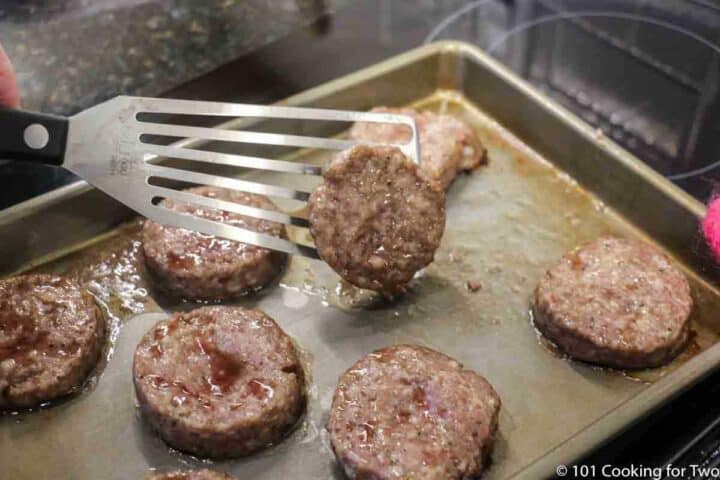The best and easiest way to cook crispy and juicy sausage is in the oven. We always bake breakfast sausage patties or links, Italian sausages, or other full-size sausages for perfect sausages every time without the mess.
🐖Ingredients
Sausage—breakfast sausage patties or links. Or larger sausages like Italian sausages, kielbasa, brats, or smoked sausages. Use pork, turkey, or chicken sausage.
PAM cooking spray or parchment paper to prevent sticking. Or aluminum foil for easy cleanup.

Jump To (scroll for more)

Featured Comment by Kari :
"Breakfast made easy! Thank you for the instructions; this worked great! "
⭐⭐⭐⭐⭐
There is no need to stand at the stove and make a mess—cooking sausage in the oven is less work, less messy, and produces better results. We haven't cooked sausage any other way for years.
Baking breakfast sausage patties or links only takes about 15 minutes, while larger sausages, like brats, kielbasa, smoked, or Italian sausages, will take about 25 minutes to cook.
Check out other great breakfast recipes, like How to Cook Bacon in a Convection Oven, Oven Baked Blueberry Pancakes, and Cinnamon Coffee Cake.
👨🍳How to Cook Sausage in the Oven—Step-by-Step Photo Instructions


You may use breakfast sausage patties or links. Or cook larger sausages like brats or Italian sausages.

1. Prepare a baking tray with sides with cooking spray, parchment paper, or aluminum foil.

2. If using breakfast sausage patties, dimple in the center to prevent puffing.


3. Evenly spread the sausage on the prepared tray.


4. Bake in a preheated 400° oven. Flip or rotate about halfway through baking.


5. Cook to an internal temp of 160° or 165° if the sausage has poultry. The cooking time for breakfast sausage is about 15 minutes and for thicker sausage about 25 minutes. You can do a few minutes under the broiler if you want more browning.
For more details, keep reading. See the Recipe Card below for complete instructions and to print.
⏲️How long to cook sausage in the oven
In a 400°F convection oven, breakfast sausage patties or links take about 15 minutes to cook while larger sausages take about 25 minutes. Cook to a final internal temperature of 160° or 165° if the sausage has poultry
Baking time will vary by the thickness of the sausage, oven temperature, amount of preheating, and even the pan can affect cooking time. So, use an instant-read thermometer and check the temperature early.
✔️Tips to make it right every time
Pork sausage, turkey sausage, or chicken sausage will all cook the same. If you cook sausage patties, dimple the center by ¼ inch and about ¾ inch in diameter to prevent puffing during cooking, which can lead to overcooking the surface before reaching a safe temperature.
Use a baking tray like a sheet pan with sides. Line the pan with foil for easy cleanup if you're making link sausage, but if you're making patties, spray the tray with PAM or add parchment paper since the spatula will frequently rip the foil.
A convection oven and a high oven temperature will both promote the sausage's browning, so use convection if you have it and a pan with low sides, like a sheet pan. But a conventional oven will also work.
This recipe quickly cooks smoked sausage, brats, kielbasa, and Italian sausage. Sliced bell pepper and onion can be added to kielbasa, smoked, or Italian sausages to make quick, delicious hoagie sandwiches or a sheet-pan dinner.
The oven temperature can match the other dishes you are cooking. I have cooked as low as 350° and as high as 450°. The time will vary, so cook by internal temperature.
If you have reached the correct temperature but the sausage is not fully browned do not bake more, but use a few minutes under the broiler for more browning.
❄️Storage and reheating leftovers
This recipe is perfect for leftovers, as you can cook a whole package at once.
To store, Seal airtight in a container or storage bag and refrigerate for 4 days. You can also freeze it for 1 to 2 months.
To reheat: If frozen, thaw overnight in the refrigerator. Microwave to reheat.
❓FAQs
No, the casing holds the juiciness in; it may break during cooking,,, but do not drain your moisture.
Yes, it will take longer since you are cooking to a temperature endpoint. The thicker the sausage and the colder your freezer, the longer it will take.
According to the USDA, ground meat is safe to eat at 160°, except ground poultry should be cooked to 165°. If you are sure there is no poultry in your sausage, you can safely stop at 160°.
Most precooked sausage is safe to eat out of the package—check the package. So you usually don't have to cook it thoroughly but just heat it through.
I prefer to cook precooked sausage for reasons of moisture and texture. Try it both ways and see which you like.

📖 Recipe

How To Cook Sausage in the Oven
Video Slideshow
Save this recipe to your inbox for later!
You may recieve the email without subscribing if you wish, but the subscription is convienent and has an easy one-ckick unsubscribe.
Ingredients
- 1 pound sausage - breakfast or other sausages
- PAM or Parchment Paper - to prevent sticking
Instructions
- Preheat the oven to 400° convection. Any oven temperature from 350° to 425° with or without convection will work—you will need to adjust time and perhaps need a couple of minutes under a broiler at the end to brown up some.
- Prepare a sheet pan baking tray with a coat of PAM cooking spray, aluminum foil, or parchment paper to prevent sticking.
- For breakfast sausage patties, make them ¾ inch thick, then dimple the patty center by about ¼ inch deep and ¾ inch diameter. This will prevent the puffing of the meat during cooking.
- Spread sausage on the prepared baking pan, so they don't touch.
- If cooking breakfast sausage patties, flip in 8 minutes. Links or round sausage should be rotated halfway through the estimated cooking time.
- The cooking time for breakfast sausage is about 15 minutes, and for thicker sausage, about 25 minutes. Cook to an internal temperature of 160° or 165° if the sausage contains poultry. If you want more browning, you can do a few minutes under the broiler.
Recipe Notes
Pro Tips
- You can use the sausage you want, breakfast links or patties, or larger sausages like Italian sausage, kielbasa, brats, or smoked sausage. You can also use pork, turkey, or chicken sausage.
- You can use uncooked or cooked sausage.
- It cooks well with other dishes since you can use different oven temperatures
- You need a pan with some sides, like a sheet pan.
- I like to use foil for sausage links due to drainage but foil will tend to rip when flipping patties. I use parchment paper or cooking spray for patties.
- Dimple the center if using patties.
- Flip or rotate about halfway through cooking.
- The most important thing is a safe internal temperature of 160° or 165° if the sausage contains poultry.
- A few minutes of the broiler may be needed at the end to get the browning you want. Do not just cook longer or you will dry the sausage.
Your Own Private Notes
To adjust the recipe size:
You may adjust the number of servings in this recipe card under servings. This does the math for the ingredients for you. BUT it does NOT adjust the text of the instructions. So you need to do that yourself.
Nutrition Estimate
© 101 Cooking for Two, LLC. All content and photographs are copyright protected by us or our vendors. While we appreciate your sharing our recipes, please realize copying, pasting, or duplicating full recipes to any social media, website, or electronic/printed media is strictly prohibited and a violation of our copyrights.
Originally Published February 14, 2015. Updated with expanded options, refreshed photos, and a table of contents to help navigation.













A.W. says
My go-to for prepping sausage patties! Works well for burger patties too, with just a few extra minutes checking with a meat thermometer! I like having fewer recipes to have to bounce between as I cook up a bunch of meat all in one weekend each month, burger patties, taco meat, ground beef/sausage, sausage patties, bacon, chicken ect... Then freeze for easy prep nights during the days/weeks when I am too tired with work to want to do much, or heat the house up on multiple days bit still want to control what additives and preservatives my kids eat. I try to avoid buying frozen meals and stuff and prefer to make my own as well as other shortcuts... The directions here are easy to follow and understand, and the sausage parties come out perfect every time! Plus I can make 2-3lbs of patties at a time, that would take forever on the stove top! Then I can just pull a few at a time from the freezer to the fridge then pop some frozen biscuit dough in the oven to bake... If only i could find a way to have thkse taste fresh made ahead of time... The search continues lol.... But at least I knlw my 14year old sons can make something filling themselves easily while I am at work, especially during the summer!
Dan Mikesell AKA DrDan says
Welcome to the blog, and it seems to be working for you.
My "after-work" cooking was pan-seared oven-roasted recipes. I would freeze a meal's worth of raw chicken breasts, pork chops, or tenderloins, which I would remove from the freezer to the fridge the evening before. Then, when I got home, I flipped on the oven, sear for a few minutes on the stovetop, and then into the oven to finish while I relaxed for a bit. Just to expand your possibilities.
Dan
PS also check out the tortilla pizzas.
Kari Hartley says
Breakfast made easy! Thank you for the instructions, this worked great! I used 3 lbs. of ground pork (added sage, marjoram, nutmeg, red pepper flakes, salt, pepper, and maple syrup) and made 10 large patties. Cooked at 400 for 8 minutes then flipped like you said, then 2 minutes under a broiler on high. SO delicious!
Helene says
Could you flatten the roll so it's like a long oval patty?
Dan Mikesell AKA DrDan says
Hi Helene,
Sure, the only caution I have is the edges may cook before the center is cooked well, and be sure to check the temperature in multiple places. I usually cut the roll with a sharp knife into 3/4 inch disks—super easy,.
Dan
Judy says
Question about reducing puffing of baked patties.
I understand the 1/4 “ dimple in the centre but what do you mean about 3/4” in diameter? Diameter is the measure from edge to edge of the pattie, this would make the pattie about the size of a quarter!
Is the 3/4 inch the thickness of the pattie?
TIA
Dan Mikesell AKA DrDan says
Hi Judy,
Welcome to the blog.
The "dimple" is just a shallow depression to prevent buffing when cooking a pattie like a burger or these sausage patties. So use a finger or two and make the depression about 1/4 inch deep in the center of the pattie on one side only. The diameter is how big around that dimple should be—about 3/4 to an inch. That is the size of the dimple, not the pattie.
The thickness of the patties is about 3/4 inch.
I hope that helps.
Dan
Kari Hartley says
I had the same question....3/4 inch patty?
Thanks for answering Dan!